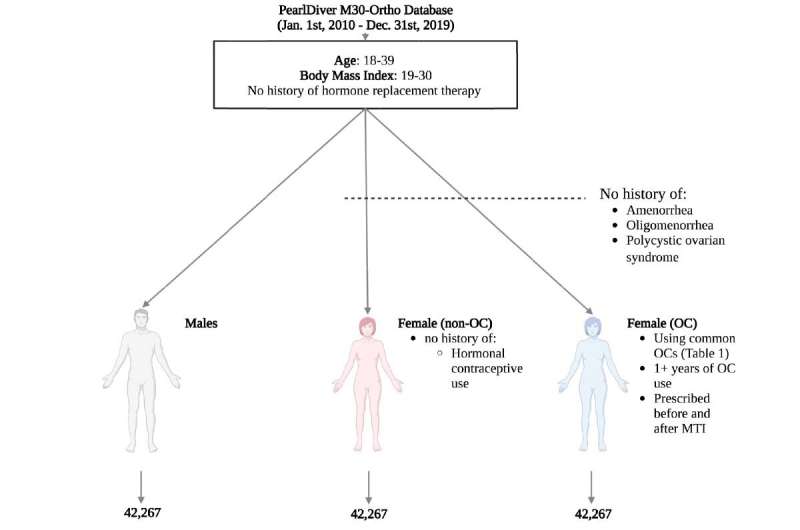This article has been reviewed according to Science X's editorial process and policies. Editors have highlighted the following attributes while ensuring the content's credibility:
fact-checked
peer-reviewed publication
trusted source
proofread
Oral contraceptive use may reduce muscle-tendon injuries

Women who take oral contraceptives may be significantly less likely to experience certain musculoskeletal injuries than women who do not take the drugs or men, according to a study by UT Southwestern Medical Center.
The findings, published in Medicine & Science in Sports & Exercise, increase the understanding of the potential protective benefits of stable hormone levels as well as possible concerns about hormone imbalances and musculoskeletal health.
Musculotendinous injuries (MTIs), which involve the connection between muscle and tendons, are among the most common types of musculoskeletal injuries in sports.
"This research offers valuable insights into how synthetic sex hormones may mitigate the risk of musculotendinous injuries in women, thereby advancing both preventive strategies and clinical interventions for a wide range of populations," said Yasin Dhaher, Ph.D., Professor of Physical Medicine & Rehabilitation and Orthopedic Surgery at UT Southwestern.
Using the national health care database PearlDiver, researchers explored an orthopedic injury dataset. They compared the percentage of MTIs involving the lower extremities with the total number of orthopedic injuries in men, in women who were prescribed oral contraceptives (OC) at least one year before their injury and were still prescribed OC after their injury, and in women with no history of OC use. The study focused on patients between the ages of 18 and 39 with normal to overweight body mass indexes (BMIs). Each cohort had 42,267 patients.
After controlling for factors such as age, BMI, and region, researchers found that women taking OC had significantly fewer MTIs (0.55% of orthopedic injuries) than women with no OC history (2.55%) and men (3.49%). Analysis also revealed potential differences in the location of MTIs (e.g., lower vs. upper leg) and among patient ages, with women between 20 and 24 years old taking OC being more likely to develop an MTI than women in the same age range with no OC history.
By studying these three cohorts, researchers were able to analyze naturally occurring differences between males and females as well as between more stable hormone concentrations from OC compared to non-OC hormone fluctuation in females. To the researchers' knowledge, this is the first study to explore the proportion of MTIs among these three groups.
"The results indicate that maintaining stable endogenous hormone levels through OC, or exposure to synthetic hormones in OC, may confer protective benefits against musculotendinous injuries in females," said Luis Rodriguez, a Ph.D. candidate in the Joint Biomedical Engineering Graduate Program between UT Dallas and UT Southwestern. "This understanding holds promise for informing the development of targeted preventive strategies and interventions aimed at reducing injury risk in women, benefiting both athletic and nonathletic populations."
The study could also provide insight into injury risk among women with conditions involving hormone imbalances, such as polycystic ovary syndrome (PCOS), menstrual cycle dysfunction, and postmenopausal hormonal changes, the researchers say.
More information: LUIS A. RODRIGUEZ et al, Oral Contraception Use and Musculotendinous Injury in Young Female Patients: A Database Study, Medicine & Science in Sports & Exercise (2023). DOI: 10.1249/MSS.0000000000003334




















